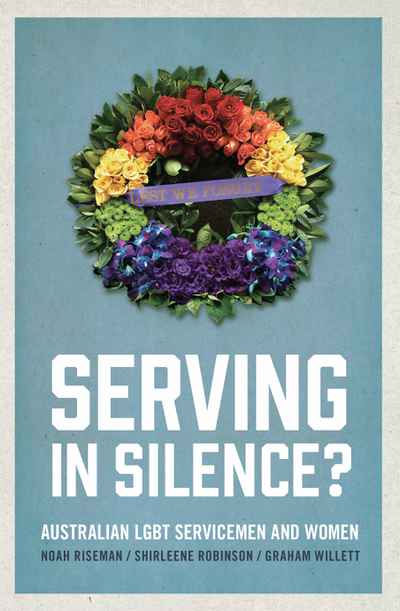This is a collection of life stories of men and women from the lesbian, gay, bisexual and transgender (LGBT) communities who are serving or have served in the various branches of the Australian Defence Force (ADF) over different historical periods. The book is the result of an Australian Research Council Discovery project documenting the history of LGBTI military service, based on; ‘…four years of oral history interviews, visits to the National Archives of Australia and the perusal of old newspapers and ephemera held at the Australian Lesbian and gay Archives (ALGA)’. The authors are all historians who have published books and articles particularly in relation to the LGBT community.

Paperback RRP: $39.99
Over 115 stories were recorded and fourteen of them presented in this book. Those selected to tell their stories were all volunteers in the military and were capable and qualified servicemen and women. Serving in Silence?’ is a collection of very personal life stories of LGBT men and women who served or are serving in the ADF.
The book is very well structured in three historical eras based on broad Defence policies and attitudes of the time: ‘Silences And Discretion, 1944 – 1973; Bans and Witch-hunts, 1974 – 1992; and From Tolerance to Inclusion, 1993 – 2018. Each section contains four stories from servicemen and women about their lives in the services as a LGBT person and the difficulties in maintaining a military career. Mostly they had to keep their sexuality a secret. They were all keen on the military as a way of life and as a career and contributed in whatever role they performed. These are very personal stories and the contributors should be commended for making them available for publication.
The authors provide ‘introductions’ to each section. This is a very useful description of the Defence policies of the day and to some extent their interpretation and implementation which puts the stories in context.
Regardless of the formal policy of the time, there seemed to be times when rules were to some extent overlooked as long as the LGBT members performed their jobs. But there were also witch-hunts where the policies were enforced inflexibly and servicemen and women, who were otherwise performing their duty, were discharged or invited to seek discharge. It may never be known how many good servicemen and women were lost to the system during these periods.
The stories are easy to read and they give a clear picture of the difficulties of serving in an organization that was not as inclusive and welcoming as it should have been. LGBT men and women lives were made difficult by the policies and attitudes of the day. The ADF has come a long way in inclusiveness since the ‘Silences and Discretion’ days.
It is a useful book for those interested in understanding the changes to personnel policy that have taken place in the ADF over time and why the changes were necessary. It will also be helpful for those developing high-level personnel policy. It provides a clear and personal account of how such high level policy impacts directly on individuals in a large organisation like the ADF. These are the stories of fellow servicemen and women who served this country and were not given a fair go.
Serving in Silence? is easy to read and is logically set out. It contains a useful Bibliography for those interested in further research.
Reviewed for RUSIV by Ian Lillie, October 2018
Contact Royal United Services Institute about this article.






